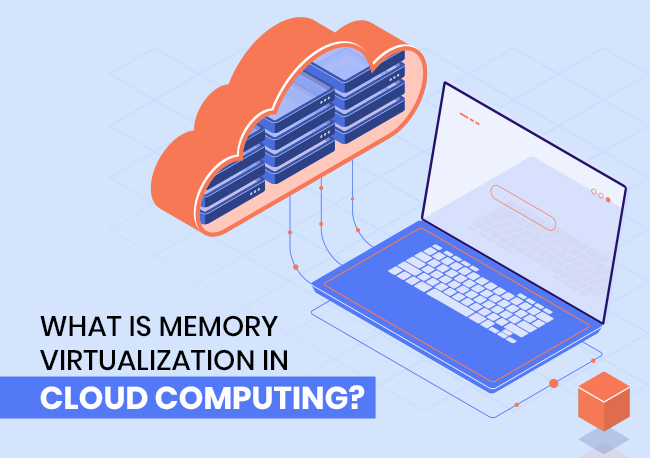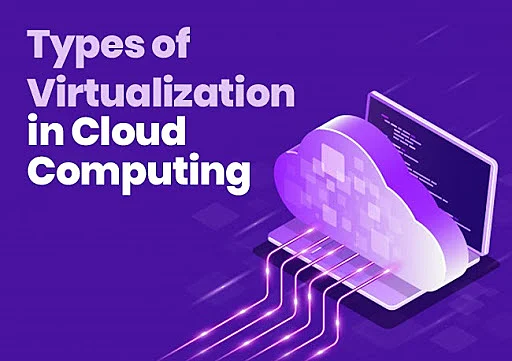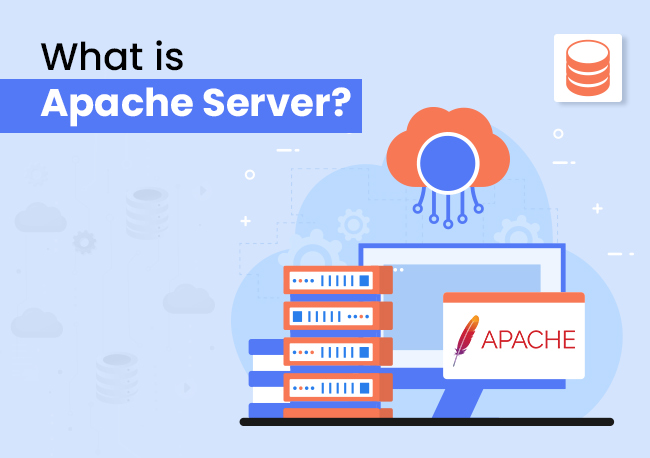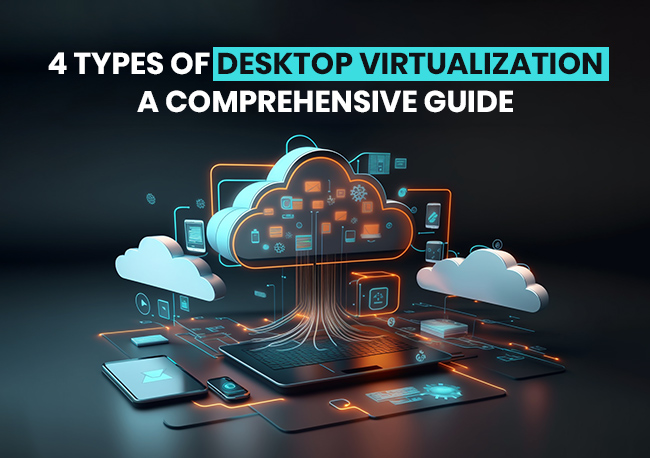| Getting your Trinity Audio player ready... |
Don’t you wonder how your computer seamlessly juggles numerous applications, from streaming music to running advanced softwares, while maintaining high performance?
But what’s the secret behind this technological magic in cloud computing?
In the world of cloud computing, where data and applications are scattered across vast networks, there’s a buzzword that directs the behind-the-scenes performance – Memory Virtualization.
It’s the reason your cloud-based services work like a finely tuned symphony, you never run out of memory when browsing the net. But what exactly is memory virtualization, and how does it make everything run seamlessly on devices?
Today, we’re about to reveal the secret of this cloud-computing marvel that makes your digital life smooth and more delightful.
What is Memory Virtualization?
Memory virtualization is like having a super smart organizer for your computer brain (Running Memory -RAM). Imagine your computer brain is like a big bookshelf, and all the apps and programs you installed or are running are like books.
Memory virtualization is the librarian who arranges these books so your computer can easily find and use them quickly. It also ensures that each application gets a fair share of the memory to run smoothly and prevents mess, which ultimately makes your computer brain (RAM) more organized (tidy) and efficient.
In technical language, memory virtualization is a technique that abstracts, manages, and optimizes physical memory (RAM) used in computer systems. It creates a layer of abstraction between the RAM and the software running on your computer. This layer enables efficient memory allocation to different processes, programs, and virtual machines.
Memory virtualization helps optimize resource utilization and secures the smooth operations of multiple applications on shared physical memory (RAM) by ensuring each application gets the required memory to work flawlessly.
Memory virtualization also decouples the volatile RAM (Temporary memory) from various individual systems and aggregates that data into a virtualized memory pool available to any system in the cluster. The distributed memory pool will be used as a high-speed cache, messaging layer, and shared memory for the CPU to increase system performance and efficiency.
*Note – Don’t confuse it with virtual memory! Virtual memory is like having a bigger workspace (hard drive) to handle large projects, and memory virtualization is like an office manager dividing up the shared resources, especially computer RAM, to keep things organized and seamless.
Also Read: What Is Apache Server And How It Works?
How is Memory Virtualization Useful in Our Daily Lives?
Basically, memory virtualization helps our computer systems to work fast and smoothly. It also provides sufficient memory for all apps and programs to run seamlessly.
Memory virtualization, a personal computer assistant, ensures everything stays organized and works properly, which is very important for the efficient working of our computers and smartphones. Whether browsing the web, working on Google documents, or using complex software, memory virtualization is the hero that provides us with a smooth and responsive computing experience in our daily lives.
Memory virtualization is essential for modern computing, especially in cloud computing, where multiple users and applications share the same physical hardware (Like RAM and System).
It helps in efficient memory management and allocation, isolation between applications (by providing the required share of memory), and dynamic adjustment based on the running workloads of various applications. Without memory virtualization, it would be challenging to run multiple applications at the same time.
Applications you may have heard about! This critical technology enables more efficient and flexible use of computing resources at both complex data centers and personal device levels. Memory virtualization is integral to personal computers, mobile devices, web hosting, app hosting, cloud computing, and data center operations.
Let’s understand how it works.
Also Read: What Is Bandwidth In Web Hosting? Things You Must Know
How Does Memory Virtualization Work in Cloud Computing?
You may be thinking all that is fine, but how does memory virtualization work in cloud computing? It’s just part of the broader concept of resource virtualization, which includes internet, storage, network, and many other virtualization techniques.
When memory virtualization takes place in cloud infrastructure, it goes through a process.
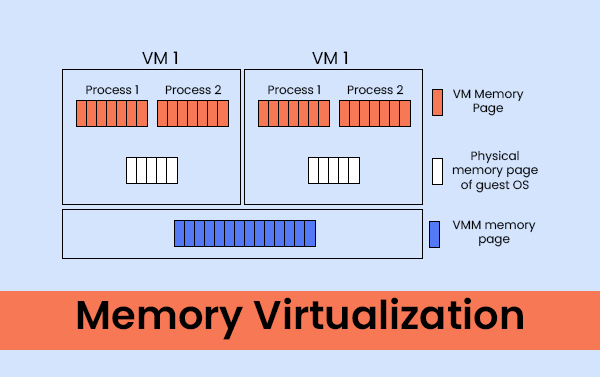
Key Elements Involved in Memory Virtualization:
1. Abstraction of Physical Memory
Like virtual memory (Hard Drive) abstracts physical memory (RAM/Cache Memory) in traditional computing, similarly, memory virtualization in cloud computing abstracts the physical memory (RAM – Running Memory) of various Virtual Machines (VMs) to create a pool of resources to allocate to a group of VMs.
For this abstraction of physical memory, Cloud service providers use a hypervisor known as a Virtual Machine Monitor (VMM) that abstracts and manages VM memory in cloud Computing.
This abstraction process allows cloud users (VMs) to request and consume memory without worrying about the storage limit. It allows users to scale their memory resources as required without concern for the underlying physical memory.
Also Read: How Much Storage Do I Need For My Website? Must-Know Factors
2. Resource Pooling
In cloud computing, there is a Cloud Data Center where multiple physical servers host various Virtual Machines (VMs) and manage their dynamic workloads.
Memory virtualization allows cloud providers to use physical memory resources efficiently, which is critical for industries such as banking. In cloud computing for banking, this technique helps optimize memory allocation to ensure smooth, secure handling of sensitive financial data and transaction workloads.
This pool can be allocated to different VMs and cloud users per their dynamic needs and workload.
Also Read: How Does A VPS Work? A Complete Guide For Beginners
3. Dynamic Allocation
Cloud service providers use memory virtualization to allocate virtual memory to VMs and Cloud users instantly on demand (According to Workload). It means cloud memory can be dynamically assigned and reassigned based on the fluctuating workload.
This elasticity of cloud computing enables effective use of available resources, and cloud users can scale up or down their cloud memory as needed. Additionally, cloud migration services help in ensuring the seamless transfer of data and applications to the cloud, enhancing the benefits of memory virtualization.
This scalability is a foundational concept in modern FinOps practices. For more insights, read the latest report on the State of FinOps.
4. Isolation and Data Security
Memory virtualization ensures that the virtual memory allocated to one cloud user or VM is isolated from others. This isolation is vital for data security and prevents one individual from accessing another’s data or memory.
That’s why many sensitive IT companies prefer to purchase private cloud services to prevent hacking and data breaches.
Also Read: Get To Know About A Web Server & Types Of Web Server
Importance of Memory Virtualization in Cloud Computing
Memory Virtualization plays a critical role in cloud computing for several reasons. It contributes to cloud services’ efficiency, scalability, effective resource utilization, and cost-effectiveness.
Here are some of the key points that show the importance of memory virtualization in cloud computing:
1. Memory virtualization allows cloud providers to use physical memory resources in the most efficient way. Overcommitting of memory allows the optimization of memory resources and hardware.
2. This virtualization enables the dynamic allocation of cloud memory to cloud user instances. This elasticity is crucial in cloud computing to manage varying workloads. It allows cloud users to scale up and down memory resources as needed and promotes flexibility and cost savings. The utilization of multi cloud management platforms is essential for effectively managing varying workloads in cloud computing.
3. Allocating separate cloud memory for every single user prevents unauthorized access and is a must for data security.
4. Memory virtualization is vital for handling a large number of users and workloads. It ensures that scaling up or down memory can be done without manual intervention whenever a VM is required.
5. Migration and live migration are important for load balancing, hardware maintenance, and disaster recovery in cloud computing. Transferring VM memory from one host to another is only possible by live migration and feasible when memory is virtualized. Implementing reliable software migration services is crucial for ensuring smooth transitions and maintaining system stability during memory virtualization processes.
6. By optimizing virtual memory usage, memory virtualization maximizes physical memory utilization and helps reduce the overall operational cost of the cloud.
Also Read: Strategies For Implementing DevOps Practices With AWS
How Does Memory Virtualization Differ From Other Virtualization Techniques?
Memory virtualization is one of the virtualization techniques used in modern computing. It’s different from other virtualizations in terms of abstraction and management. Here are some key differences between memory and other virtualization techniques.
Memory Virtualization vs. Server Virtualization
Memory Virtualization
- Abstracts and manages memory resources.
- Focus on optimizing memory uses, ensuring isolation.
- Enable dynamic allocation of Memory to VMs.
Server virtualization
- Abstracts and manages the entire server ( CPU, memory, and storage).
- Run multiple isolated VMs on a single physical server.
- Splits the physical server into multiple virtual servers.
Memory Virtualization vs. Storage Virtualization
Memory Virtualization
- Abstracts and manages memory resources (RAM and Cloud memory).
- Optimizes memory allocation and facilitates dynamic memory allocation.
Memory Virtualization
- Abstracts and manages memory resources (RAM and Cloud memory).
- Optimizes memory allocation and facilitates dynamic memory allocation.
Storage Virtualization
- Abstracts and centralizes storage resources.
- Allows users to manage storage capacity and data across multiple storage systems.
- Provides features like data redundancy and data migration.
- Help the system with consistent performance and maintaining smooth operations.
Memory Virtualization vs. Network Virtualization
Memory Virtualization
- Focus on managing the allocation and optimization of memory resources.
- Not directly dealing with network-related resources; it only deals with memory.
Network Virtualization
- Abstracts and separates network resources.
- Enable multiple virtual networks to coexist on the same physical network infrastructure.
- Provides isolation, segmentation, and management of network resources.
Memory Virtualization vs. Desktop Virtualization
Memory Virtualization
- Operates at the hardware level (RAM).
- Manage memory resources available to running processes, applications, or virtual machines.
- Used in almost every digital device, from laptops to smartphones.
Desktop Virtualization
- Abstracts the entire desktop system, including the operating system, applications, and user data.
- Allow users to access their desktops virtually from any device while maintaining consistent configurations and data.
- Commonly used in the IT industry and IoT companies.
Also Read: 4 Types Of Desktop Virtualization – A Comprehensive Guide
Memory Virtualization vs. Application Virtualization
Memory Virtualization
- Primarily concerned with managing system memory.
- Ensures efficient allocation and usage of memory for running processes.
Application Virtualization
- Individual applications are abstracted from the underlying operating system, allowing them to run independently and without conflict.
- Allows users to access and use the program from any connected system to the server.
- Frequently used for compatibility and security reasons.
Also Read: Types Of Virtualization In Cloud Computing-Complete Overview
Applications of Memory Virtualization in the Digital World
In the digital world, memory virtualization offers a diverse range of applications. This is a key component of the internet technology to drive innovation and transform the landscape of modern computing.
It enables more efficient resource utilization, improved system performance, and smooth user experience across a range of technological domains.
Technical domains where memory virtualization plays a crucial role:
- Cloud Computing: In shared cloud environments, memory virtualization ensures that each virtual machine (VM) has an isolated memory and gets the required memory whenever needed. It plays a major role in efficient memory utilization and reducing running costs.
- High-Performance Computing (HPC): In HPC clusters, it ensures that memory is efficiently allocated to multiple processes parallelly for seamless, complex scientific simulations and big data analysis. Also helps in the allocation of memory resources based on the specific need of each task in the HPC cluster.
- Data Centers: Large enterprises with heavy data load require memory virtualization to run multiple applications on a shared server. It simplifies the resources where multiple teams and departments have varying memory requirements and dynamic loads.
- Memory virtualization is crucial for database management to efficiently allocate memory to various databases when multiple databases run on a single server.
- Resource-Constrained Environment: When computers have limited physical space(RAM), memory virtualization helps optimize memory usage and prevent resource contention. This process helps in better memory balancing and system performance.
- Help in Disaster Recovery: Memory virtualization enables the transfer of memory between two data centers and maintains services during failure.
- Testing and Development of Applications: Utilized in simulated real-world conditions and tested application performance under various regulations.
- IoT and Edge Computing: New edge applications and devices use memory virtualization for efficient RAM allocation and isolation of cache for different apps and websites. For example, when you use two different apps on your mobile device, one app can’t access another app’s data without your permission.
- For those interested in creating interconnected devices, exploring IoT application development can provide insights into building efficient and innovative solutions.
Also Read: 5 Best Website CMS Detector Tools You Must Try
Future of Memory Virtualization in Cloud Computing
The future of memory virtualization in cloud computing holds significant promise as cloud technology continues to evolve and become more integral to our digital world. Several trends and developments are likely to shape the future of memory virtualization:
- Increasing Demand for Memory Efficiency
In upcoming years, cloud workloads will become more diverse and intense, which will require efficient memory management. Memory virtualization will play a crucial role in optimizing memory allocation and achieving higher performance.
- Enhancing Data Security and Memory Isolation
Data breaches and hacking threats are rising daily, and countries concerned about data security and privacy around the globe make this more vulnerable. So, it will be essential for cloud providers to offer improved isolation and security features in cloud computing.
Memory virtualization will play a key role in data security, where multiple cloud users share the same cloud storage.
- AI and Machine Learning Integration
Memory virtualization will be used to support AI and machine learning workloads that require huge storage capacity, like ChatGPT, Bard, and AI-powered automation applications. It’s used in memory allocation and storage utilization to enhance user experience.
- Quantum Computing Solutions
With the advancement of quantum computing, memory virtualization will adapt to unique memory requirements in complex quantum algorithms and programs. That’s why several companies are working on specialized memory management solutions based on memory virtualization for quantum computing.
- For Blockchain Technologies Integration
We all know that blockchain is a futuristic technology adopted by every sector, from banking to healthcare to IoT. Memory virtualization will be used to manage blockchain networks and decentralized applications.
- Reduce Energy Consumption
Most nations are currently focusing on effective energy utilization and high efficiency. This led to the development of memory virtualization solutions that minimize energy consumption. Big data centers and cloud infrastructure companies currently use this technology to minimize energy consumption.
- Other Future Applications
Memory virtualization will be used in various other sectors in upcoming years, such as edge computing expansion, custom memory allocation, distributed cloud architecture, and serverless computing.

To Conclude
We hope this article gives you a clear idea of “What is memory virtualization” and how it works behind the scenes to give us a seamless computing experience. The future of memory virtualization holds promise, with advancements in technology and software enabling more efficient memory management and scalability, making it a key player in the ever-evolving world of computing.
